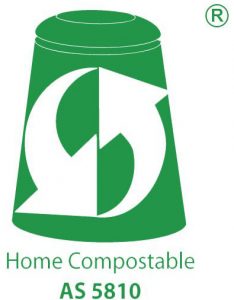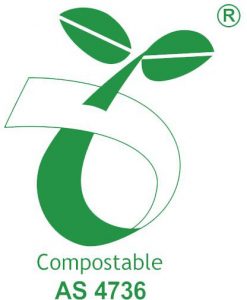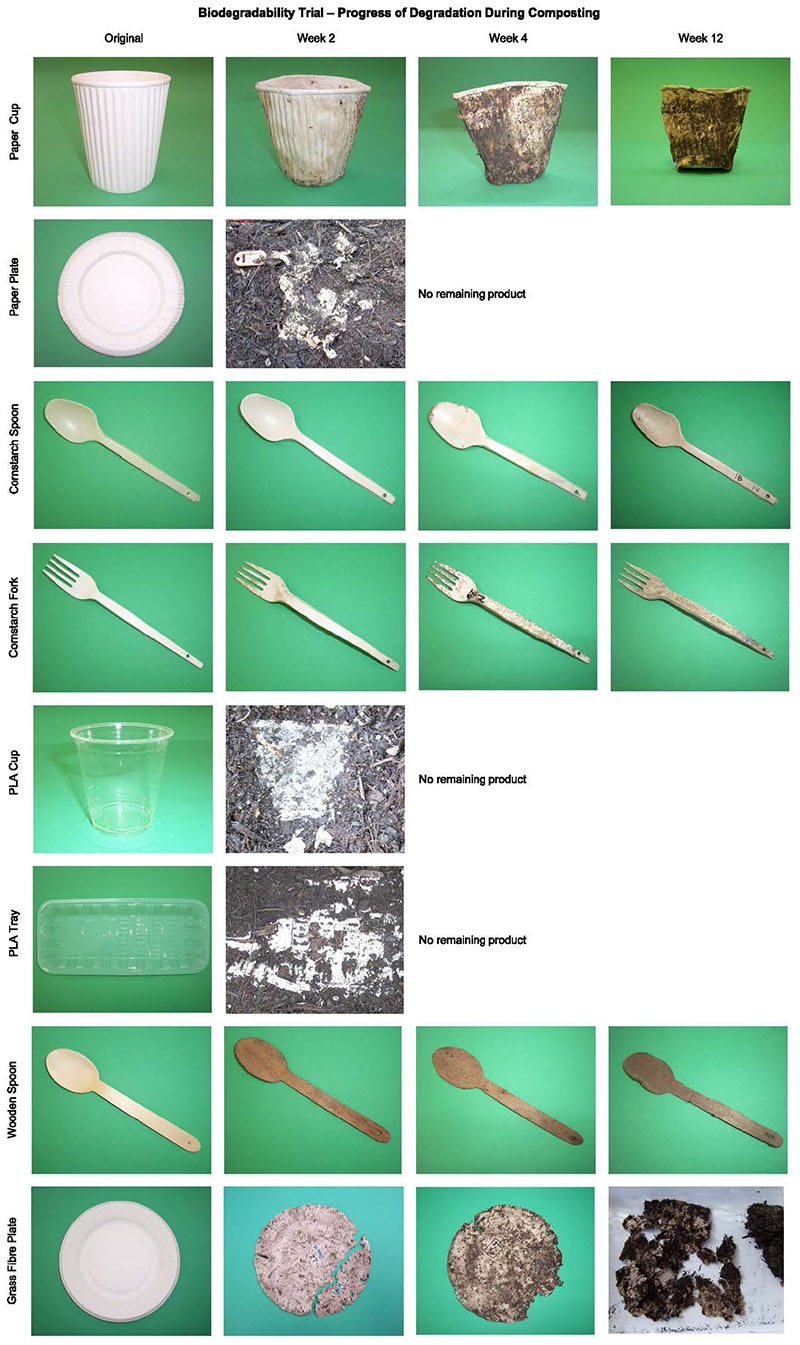Coffee cups, lids and compostability
Lucinda Flynn, from Hurstbridge, is the owner of Going Green Solutions, a local company that sells eco-products. During September 2020, there was a debate between some of the readers of this website about the compostability or otherwise of takeaway coffee cups and their lids. As Lucinda sells such cups, and is therefore knowledgeable about the issues, we asked her to write an article for this website.
First, by way of introduction, Jules Jay, from Hurstbridge, introduces the terminology.
There are big differences between the terms biodegradable, compostable, and home compostable. This page from the CSIRO website explains some of the differences.
Biodegradable items are often made from plastics that simply ‘break down’ into millions of tiny pieces (becoming microplastics), rather than reverting to natural substances that feed soil. This degrading process can take many years, so they’ll likely never break down in a compost bin.
Compostable items can be confusing, as they fall into two categories.
Much of what is labelled ‘compostable’ can only be broken down in industrial composting facilities at high heat levels over a specific time period – and certainly not quickly in a home compost bin.

 Only packaging labelled as ‘home compostable‘ will break down to become organic soil in the compost bin.
Only packaging labelled as ‘home compostable‘ will break down to become organic soil in the compost bin.
Finally, to clarify the various certifications currently available. Australia has separate certifications (and logos) for home compostability (standard AS5810) and for commercial compostability (standard AS4736). Internationally, there are currently no standards for home compostability but there are for commercial compostability (the European standard EN13432). The Australian AS4736 and International EN13432 standards are similar except that the former has an additional test for any residual toxicity of the composted material to earthworms.
What is the most eco-friendly option?
Without a doubt, the most environmentally friendly option for a coffee cup is a re-usable one that is re-used for many years before disposal.
However, in my opinion, this is not always a realistic option, and thus single-use disposable items are a reality of our first world lifestyle that we need to factor in for the foreseeable future.
Why aren’t there home compostable cups and lids?
Sometimes people seem annoyed or frustrated that the cups and lids are only ‘commercially compostable’ and not easily ‘home compostable’, as if the companies have made a choice to add this extra hurdle.
My understanding it that it is currently just not possible to make a waterproof product that is certified home compostable. Non waterproof – absolutely, and I sell lots of home compostable plates, bowls, boxes and trays. But, currently at least, waterproof products generally need the heat and movement of a commercial facility.
Do ‘compostable’ products actually compost?
If a product is certified commercially compostable to Australian standard, then it will definitely compost in a commercial facility.
Likewise, if a product is certified home compostable to Australian Standard, then it will definitely compost in a home compost.
Both of these certifications are challenging to achieve, demand rigorous, thorough environmental testing, and can be depended on.
The only two instances in which a ‘compostable’ item might not compost are: 1) when the product claims to be compostable but has not actually achieved certification or 2) when you are composting it to the wrong standard, for example, trying to home compost an item that is commercially compostable.
So, where are we at right now?
Cups and lids can be ‘conventional’, ‘biodegradable’/’degradable’ or ‘commercially compostable’.
Conventional plastic coated cup and plastic lid
The conventional single-use coffee cup is plastic-coated, with the lid being recyclable plastic. The best case scenario is that the lid will be recycled. In practice, whilst some lids will be recycled, most cups and any lids will go to landfill or into the environment.
- The plastic is made from non-renewable fossil fuels.
- There are no other redeeming qualities that I am aware of.
‘Biodegradable’/’degradable’ cup and lid
‘Biodegradable’, and especially the term ‘degradable’, are rather ambiguous terms which often mean mean that the oil-based plastic has been treated with chemicals to make it break down into smaller parts. I avoid ‘degradable’ items like the plague – what could be worse than small parts of plastic in the environment?
Commercially compostable cup and lid
Using the Biopak brand ‘biocup’ as an example (as I know most about it): this product is certified to break down into organic matter in a single commercial composting cycle (6-8 weeks usually). Where a business has signed up to the Biopak Compost Service, everything that goes into their bins is composted (and the end result is pure compost, with no trace of plastic left, and no detrimental impact on worms or micro-organisms – see this note on the requirements for certification from The Australasian Bioplastics Association). Where this service is not available or not used, the cups and lids will go to landfill.
Note that my home compost can break down biocups without any trouble (because the PLA bioplastics lining is so thin), but not the lids – the PLA is too thick and my compost is not hot enough.
What is the ideal future?
In the absence of certified ‘home compostable’ cups and lids, the key issue is how much of an advance are ‘commercially compostable’ cups and lids?
Many of the comments around this issue are along the lines of – “most people can’t access commercial composting, so why bother buying so called ‘compostable’ cups and lids if we can’t compost them?”
Yes, it is true that currently much of the time the commercially compostable cups and lids do still go to landfill. However, the progress towards linking catering ware with commercial composting has been substantial in the last few years, and I believe that the more we participate in the move away from conventional products, that faster we will make progress,
Here is an example: Biopak is working to expand the commercial composting availability across Australia and it is now available to businesses in around 2,100 suburbs across Australia and New Zealand.
Furthermore, all the pulp used is FSC certified and 100% made from annually renewable plant materials (the plastic is plant-based rather than oil-based). The company also purchases carbon offsets from manufacture right through to disposal. So, even if someone cannot commercially compost the take-away cup they got their coffee in, isn’t it still a better option than conventional?
In this context, I suggest that the ideal future scenario is one in which:
- The only single-use disposables allowed are those which are certified commercially compostable.
- There are commercial composting facilities available in all suburbs.
I would like to see a complete ban on single-use plastics made from fossil fuels and a move to only annually renewable plant based PLA bioplastics, which can be composted along with food scraps.
This is actually not a pipe-dream: from 2021, Hobart City Council will ban all non-compostable single-use plastics. If Hobart City Council can do it, why can’t the rest of Australia? And as and when other councils do join them, commercially compostable bioplastics will come into their own and the change will create a matching demand for commercial composters who accept this waste.
And finally …
Here is a great graphic from a 2005(!) report that first got me interested in this subject (Assessment of biodegradable catering products, produced by Flinders Bioremediation Pty Ltd for Zero Waste SA). Note that the ‘paper cup’ in the graphic is a conventional plastic coated paper cup (this was before there was any such thing as a PLA coated paper cup) – you can see that it does not compost, and yet the PLA products compost very quickly.


I put any Biopak branded cups and lids through a 5 HP petrol chipper/mulcher. Composts quite well in my less than perfect compost heap. The lids shatter into tiny pieces and the cups are torn up to about a 50 cent piece.